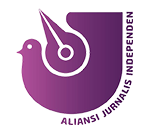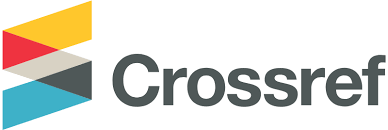Democracy on Social Media: The Analysis of the New Criminal Code Ratification Polemic on Twitter
Abstract
Keywords
Full Text:
PDFReferences
Abdullah, A., & Hidayat, D. R. (2018). Internet and prostitution activities. Journal of Physics: Conference Series, 1114(1), 1–4. https://doi.org/10.1088/1742-6596/1114/1/012060
Ahmed, W., Vidal-Alaball, J., Segui, F. L., & Moreno-Sánchez, P. A. (2020). A social network analysis of tweets related to masks during the COVID-19 pandemic. International Journal of Environmental Research and Public Health, 17(21), 1–9. https://doi.org/10.3390/ijerph17218235
Aisyah, P. N., Nusantara, G., & Sjafirah, N. A. (2022). Analisis jejaring sosial peran pers dalam penyebaran informasi terkait kebijakan PPKM. Jurnal Komunikasi Global, 11(1), 43–65. https://doi.org/10.24815/jkg.v11i1.24555
Ali, D. J., & Eriyanto. (2021). Political polarization and selective exposure of social media users in Indonesia. Jurnal Ilmu Sosial Dan Ilmu Politik, 24(3), 268–283. https://doi.org/10.22146/JSP.58199
Arianto, B. (2017). Menakar peran relawan politik pasca kontestasi presidensial 2014. Jurnal Ilmu Sosial Dan Ilmu Politik, 20(1), 50–68. https://doi.org/10.22146/jsp.18000
Bakry, G. N., & Kusmayadi, I. M. (2021). Peran pers sebagai aktor gerakan digital tagar #SolidaritasUntukNTT di Twitter. Jurnal Kajian Jurnalisme, 5(1), 98–114. https://doi.org/10.24198/jkj.v5i1.33458
Barisione, M., & Ceron, A. (2017). A digital movement of opinion? Contesting Austerity through social media. In Social Media and European Politics (Issue June). Palgrave Macmillan. https://doi.org/10.1057/978-1-137-59890-5
Borgatti, S. P., Everett, M. G., & Johnson, J. C. (2013). Analyzing social network (J. Seaman (ed.)). SAGE Publications.
Borgatti, S. P., & Halgin, D. S. (2011). On network theory. Organization Science, 22(5), 1168–1181. https://doi.org/10.2139/ssrn.2260993
Borgatti, S. P., & Ofem, B. (2010). Overview: Social network theory and analysis. In A. J. Daly (Ed.), The Ties of Change: Social Network Theory and Application in Education (pp. 17–30). Harvard University Press.
Cahyaningrum, N. I., Fatima, D. W. Y., Kusuma, W. A., Ramadhani, S. A., Destanto, M. R., & Nooraeni, R. (2020). Analysis of user sentiment of Twitter to draft KUHP. Jurnal Matematika, Statistika Dan Komputasi, 16(3), 273–286. https://doi.org/10.20956/jmsk.v16i3.8239
Carty, V. (2014). Arab spring in Tunisia and Egypt: The impact of new media on contemporary social movements and challenges for social movement theory. International Journal of Contemporary Sociology, 51(1), 51–80. https://digitalcommons.chapman.edu/sociology_articles/12/
Castells, M. (2011). A network theory of power. International Journal of Communication, 5, 773–787. https://ijoc.org/index.php/ijoc/article/view/1136/553
Dewantara, R. W., & Widhyharto, D. S. (2016). Aktivisme dan kesukarelawanan dalam media sosial Komunitas Kaum Muda Yogyakarta. Jurnal Ilmu Sosial Dan Ilmu Politik, 19(1), 40–52. https://doi.org/10.22146/jsp.10855
Diba, S. F. (2019). Implementasi metode Naive Bayes Classifier dalam analisis sentimen pada opini masyarakat terhadap RKUHP [Universitas Islam Indonesia]. https://dspace.uii.ac.id/handle/123456789/20258
Earl, J., & Kimport, K. (2011). Digitally enabled social change: Activism in the internet age. The MIT Press.
Eriyanto. (2021). Analisis jaringan media sosial: Dasar-dasar dan aplikasi metode jaringan sosial untuk membedah percakapan media sosial. Kencana.
Eriyanto. (2022). Analisis jaringan komunikasi: Strategi baru dalam penelitian ilmu komunikasi dan ilmu sosial lainnya. Prenadamedia Grup.
Fuadi, A. (2020). Social media power for protest in Indonesia: The Yogyakarta’s #gejayanmemanggil case study. Jurnal Studi Komunikasi (Indonesian Journal of Communications Studies), 4(3), 541–552. https://doi.org/10.25139/jsk.v4i3.2438
Gaisbauer, F., Pournaki, A., Banisch, S., & Olbrich, E. (2021). Ideological differences in engagement in public debate on Twitter. PLoS ONE, 16(3), 1–18. https://doi.org/10.1371/journal.pone.0249241
Hasna, S. (2022). Peran opinion leaders sebagai gatekeepers: Social network analysis penolakan RUU KUHP di Twitter #HidupMahasiswa 2019 [Universitas Gadjah Mada]. https://etd.repository.ugm.ac.id/penelitian/detail/211308
Hwang, H., & Kim, K. O. (2015). Social media as a tool for social movements: The effect of social media use and social capital on intention to participate in social movements. International Journal of Consumer Studies, 39(5), 478–488. https://doi.org/10.1111/ijcs.12221
Ihsan, I. (2021). Sentiment analysis RKUHP pada Twitter menggunakan metode support vector machine. E-Proceeding of Engineering, 8(2), 3520–3536. https://openlibrarypublications.telkomuniversity.ac.id/index.php/engineering/article/view/14735
Iosifidis, P., & Wheeler, M. (2015). The public sphere and network democracy: Social movements and political change? Global Media Journal, 13(25), 1–17. https://www.globalmediajournal.com/open-access/the-public-sphere-and-network-democracy-social-movements-and-political-change.pdf
Juditha, C. (2016). Demokrasi di media sosial: Kasus polemik Rancangan Undang-Undang pemilihan kepala daerah. Jurnal Penelitian Komunikasi Dan Pembangunan, 17(1), 1–16. https://doi.org/10.31346/jpikom.v17i1.1354
Juniarto, D. (2016). Menyoal demokrasi digital di Indonesia. Jurnal Dialog Kebijakan Publik, 22, 28–35.
Medistiara, Y. (2022). Kejagung siap beri pendampingan hukum jika KUHP digugat ke MK. Detiknews. https://news.detik.com/berita/d-6472228/kejagung-siap-beri-pendampingan-hukum-jika-kuhp-digugat-ke-mk
Meel, P., & Vishwakarma, D. K. (2020). Fake news, rumor, information pollution in social media and web: A contemporary survey of state-of-the-arts, challenges and opportunities. Expert Systems with Applications, 153, 112986. https://doi.org/10.1016/j.eswa.2019.112986
Neely, S. R., & Collins, M. (2018). Social media and crisis communications: A survey of local governments in Florida. Journal of Homeland Security and Emergency Management, 15(1), 1–13. https://doi.org/10.1515/jhsem-2016-0067
Neogi, A. S., Garg, K. A., Mishra, R. K., & Dwivedi, Y. K. (2021). Sentiment analysis and classification of Indian farmers’ protest using Twitter data. International Journal of Information Management Data Insights, 1(2), 100019. https://doi.org/10.1016/j.jjimei.2021.100019
Nugraheny, D. E. (2022). KUHP hasil revisi tak langsung berlaku ada waktu 3 tahun untuk sosialisasi. Kompas.Com. https://nasional.kompas.com/read/2022/12/07/10104931/kuhp-hasil-revisi-tak-langsung-berlaku-ada-waktu-3-tahun-untuk-sosialisasi
Olubunmi, A. P. (2015). The ambiguous power of social media: Hegemony or resistance ? New Media and Mass Communication, 33, 1–10. https://iiste.org/Journals/index.php/NMMC/article/view/19213
Papacharissi, Z., & Oliveira, M. de F. (2012). Affective news and networked publics: The rhythms of news storytelling on #Egypt. Journal of Communication, 62(2), 266–282. https://doi.org/10.1111/j.1460-2466.2012.01630.x
Ramadhan, A., & Setuningsih, N. (2022). Mahfud MD tegaskan pasal penghinaan presiden bukan untuk lindungi Jokowi. Kompas.Com. https://nasional.kompas.com/read/2022/12/15/16593941/mahfud-md-tegaskan-pasal-penghinaan-presiden-bukan-untuk-lindungi-jokowi
Ramadhani, A., & Arianto, I. D. (2022). Digital activism rancangan Undang-Undang tindak pidana kekerasan seksual. Jurnal PIKMA: Publikasi Media Dan Cinema, 5(1), 68–102. https://jurnal.amikom.ac.id/index.php/pikma/article/view/848
Rico, J. (2022). Indonesia patut bangga miliki KUHP sendiri. InfoPublik. https://www.infopublik.id/kategori/nasional-politik-hukum/691977/indonesia-patut-bangga-memiliki-kuhp-sendiri
Rizal, A. (2019). Pengguna Twitter di Indonesia paling banyak pria daripada perempuan. Grid.Id. https://infokomputer.grid.id/read/121705568/pengguna-twitter-di-indonesia-paling-banyak-pria-daripada-perempuan?page=all
Safitri, R., Alfira, N., Tamitiadini, D., Febriani, N. S., & Dewi, W. W. A. (2021). Analisis sentimen: Metode alternatif penelitian big data. UB Press.
Shafira, I. D., & Wibowo, E. A. (2022). Hari ini RKUHP disahkan, ini pasal yang masih jadi sorotan. Tempo.Co. https://nasional.tempo.co/read/1664939/hari-ini-rkuhp-disahkan-ini-pasal-yang-masih-jadi-sorotan
Sitorus, A. M. H. (2022). Social Network Analysis (SNA) tentang protes digital di Twitter: Studi pada tagar #CabutPermenJHT56Tahun. Sosioglobal: Jurnal Pemikiran Dan Penelitian Sosiologi, 7(1), 82–94. https://doi.org/10.24198/jsg.v7i1.38611
Smith, M. a, Rainie, L., Himelboim, I., & Shneiderman, B. (2014). Mapping Twitter topic networks: From polarized crowds to community clusters. The Pew Research Center, February 20, 1–57. https://www.pewresearch.org/internet/2014/02/20/mapping-twitter-topic-networks-from-polarized-crowds-to-community-clusters/
Sumartias, S., Pulubuhu, D. A. T., Sudarmono, S., Noorlistyo Adi, A., & Ratnasari, E. (2023). Democracy in the Indonesian digital public sphere: Social network analysis of Twitter users’ sesponses to the issue of nationalism knowledge test at the corruption eradication commission (TWK-KPK). Jurnal Ilmu Sosial Dan Ilmu Politik, 26(3), 240–257. https://doi.org/10.22146/jsp.70896
Susanto, E. H. (2017). Media sosial sebagai pendukung jaringan komunikasi politik. Jurnal ASPIKOM, 3(3), 379–398. https://doi.org/10.24329/aspikom.v3i3.123
Sutan, A. J., Nurmandi, A., Mutiarin, D., & Salahudin, S. (2021). Using social media as tools of social movement and social protest in omnibus law of job creation bill policy-making process in Indonesia. In T. Antipova (Ed.), Advances in Intelligent Systems and Computing (pp. 261–274). Springer Nature Switzerland. https://doi.org/10.1007/978-3-030-71782-7_24
Tang, Z., Zhang, L., Xu, F., & Vo, H. (2015). Examining the role of social media in California’s drought risk management in 2014. Natural Hazards, 79(1), 171–193. https://doi.org/10.1007/s11069-015-1835-2
Utami, S. R., Safitri, R. N., & Kuncoroyakti, Y. A. (2021). Network analysis and actors #CancelOmnibusLaw on Twitter social media using Social Network Analysis (SNA). Journal of Media and Communication Science, 4(3), 135–148. https://doi.org/10.29303/jcommsci.v4i3.111
Wukich, C. (2016). Government social media messages across disaster phases. Journal of Contingencies and Crisis Management, 24(4), 230–243. https://doi.org/10.1111/1468-5973.12119
Yahmin, Z. (2022). Bantah PBB, pemerintah tegaskan KUHP tidak bertentangan dengan HAM. RilisID. https://m.rilis.id/Nasional/Berita/Bantah-PBB-Pemerintah-Tegaskan-KUHP-Tidak-Bertentangan-dengan-HAM-jKT8ne9
Zempi, C. N., & Rahayu. (2019). Social media in the anticorruption movement: Social Network Analysis on the refusal of the “Koruptor Boleh Nyaleg” decision on Twitter. Jurnal Komunikasi Indonesia, 8(2), 92–103. https://doi.org/10.7454/jki.v8i2.11195
DOI: https://doi.org/10.24198/jkj.v7i1.46588
Refbacks
- There are currently no refbacks.
Copyright (c) 2023 The Author(s)

This work is licensed under a Creative Commons Attribution-NonCommercial-ShareAlike 4.0 International License.
Kajian Jurnalisme Indexed by:
Editorial Office of Kajian Jurnalisme:
Journalism Study Program, Faculty of Communication Sciences, Universitas Padjadjaran
Building 3 2nd Floor, Jl. Raya Bandung Sumedang KM.21, Jatinangor, Sumedang Regency, West Java 45363
Email: kajian.jurnalisme.fikom@unpad.ac.id
Telepon: (022) 7796954
Faks: (022) 7794122
Kajian Jurnalisme Supervised by:













